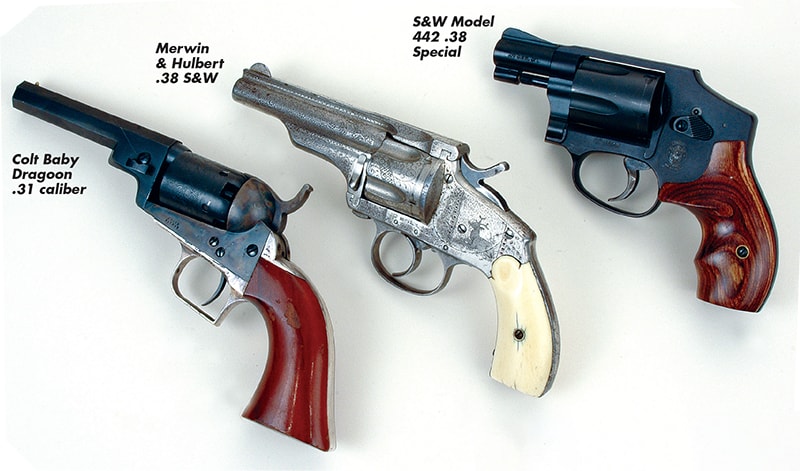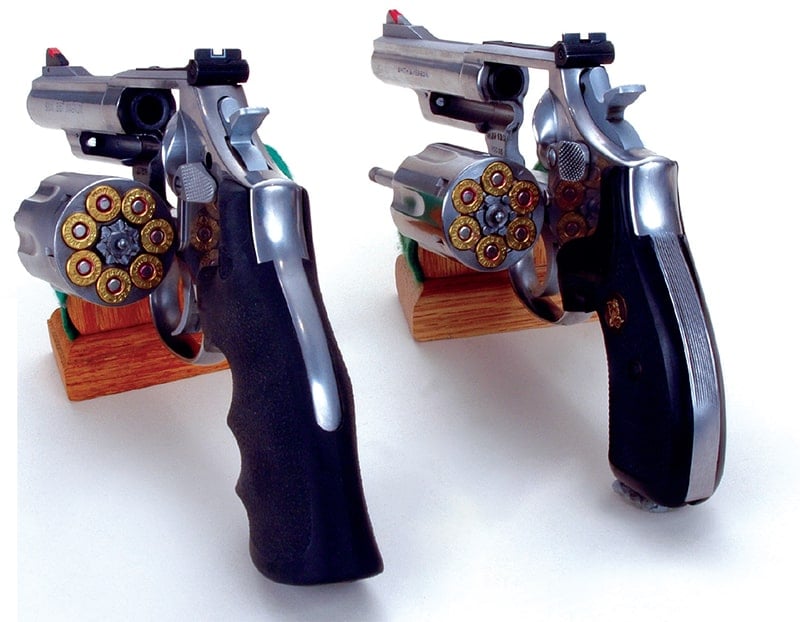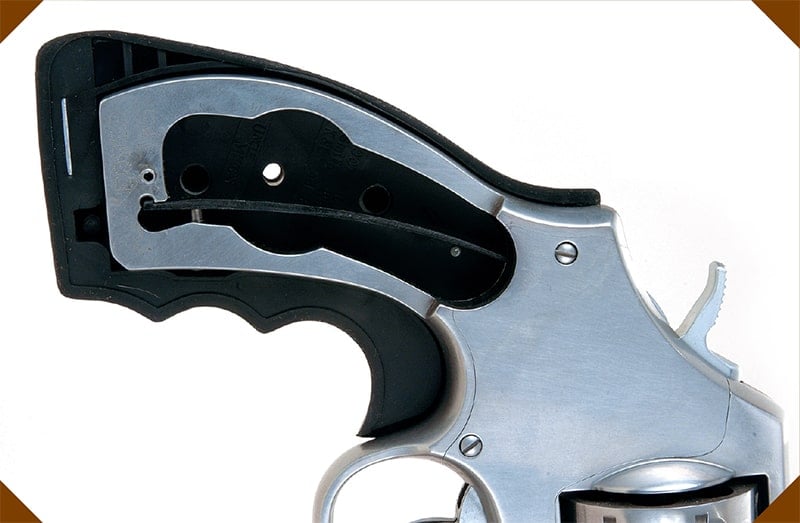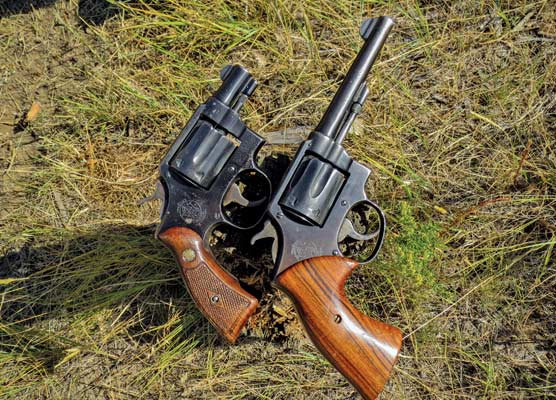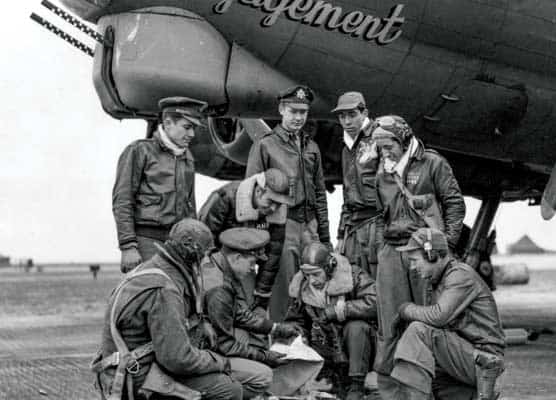Sixguns More Or Less?
S&W's "Sevenguns"
Sixgun has always been another word for revolvers. A catchy, more imaginative description than saying revolving handgun. Elmer Keith didn’t write a book called Revolvers. His most famous work was Sixguns. John Taffin’s newest book isn’t titled Single Action Revolvers; its title is Single Action Sixguns.
Almost all of the world famous revolvers have been sixguns. The Colt “Navy” so often mentioned in fact and fiction was a sixgun. So were the Peacemaker, the Schofield, the “triplelock” and the Model 29.
All sixguns are revolvers. Yet all revolvers are not sixguns, nor have they ever been. One of the very first Colt percussion revolvers was the diminutive .31 caliber Baby Dragoon. It was a five-shooter intended for well dressed gentlemen to carry in their coat pockets. I’ve got a nifty little engraved, ivory-gripped, Merwin & Hulbert .38 caliber revolver from the 1880s laying here on my desk. It’s a five-shooter too. The very first revolver I ever fired at age 6 was a very old, nickel-plated, pearl gripped, Smith & Wesson .22 caliber Ladysmith. It had seven chambers. I remember that distinctly.
Why then did I blow raspberries in disgust when my friend Tony Miele of Smith & Wesson unpacked a S&W Model 620 .357 Magnum and handed it to me? That was when we both attended a Thunder Ranch Revolver Class years back. Because when I opened the cylinder it had seven holes! I fussed and grumbled at Tony demanding, “Why is Smith & Wesson doing this? Revolvers are supposed to be SIXGUNS!”
Tony fought back. “No they’re not,” he said. “Our J-frame .38s have always been five-shooters, and our X-frame .500s are five-shooters, and we’ve made 10-shot .22s and eight-shot whatevers. There’s nothing sacred about six chambers. Besides, you only carry five shots in those antique old single actions you’re always blathering about.”
Finally Clint broke us up. He said, “Duke, shut up. That seventh shot might be the one that saves your life.” I did, but not gracefully and throughout the class I got a few digs in at “Tony and his seven-gun.” Which, incidentally, he shot very well.
Duke Learns
Just as you can shut up a dog’s yapping by throwing them a bone, Tony set out to loosen up my straitlaced mind. When he got back to Springfield he sent me out a couple of seven-shooters for me to “play with.” They’re Models 619 and 620, 4″, stainless steel, .357 Magnums.
The uninitiated (which I was) might ask, “So what’s a Model 619 and 620: some sort of modernized Model 19?” That’s a definite yes and no. Yes as in these revolvers were introduced to replace the now discontinued Model 19 and its stainless counterpart, the Model 66. Those two were built on Smith & Wesson’s famous K-frame. The Models 619 and 620 are on Smith & Wesson’s newer L-frame, which is a beefed up medium-sized frame on which they will now put all mid-size .357 Magnum revolvers. The K-frame will be reserved for .38 Specials. The Lframe is slightly heavier and has a slightly larger “window,” which is what the factory calls that big space where the cylinder goes. The window has to be slightly larger to accept the larger diameter seven-shot cylinder.
A Model 19’s cylinder measures 1.458″ in diameter. Those on the Models 619 and 620 are 1.564″. The revolver windows correspond in size at 1.471″ and 1.598″ in the same order. Interestingly, the newer cylinders are slightly shorter than a Model 19’s: 1.63″ as opposed to 1.675″. In practical terms what all these numbers mean is the new medium frame S&W .357 Magnums will weigh about 1.5 to two ounces more than the Model 19s and Model 66s they replace.
For that increase, as I was so powerfully told, you get another round in the cylinder. My opinion is S&W was able to keep these weights so close because the older guns were built on a square butt frame and the newer ones have round butts encased under those finger groove rubber grips.
Some Differences
Worth mentioning too are the basic differences between a Model 619 and a Model 620. They are simple: the Model 620 wears Smith & Wesson’s standard fully adjustable rear sight along with their ramp front with red insert. The Model 619’s sights are the traditional fixed, groove-in-topstrap with low ramp front. Also the Model 620 has the ejector rod shroud just as the old Model 19s & 66s did, but the Model 619 is without such. Hammer spurs are checkered, but the narrow triggers are smooth, which is a nice feature in my book, after having so many serrated double-action revolver triggers peel hide from my finger.
Barrels on these new .357 Magnum revolvers (not sixguns!) are stout. My samples measure .76″ at the muzzle. A Model 19 with 6″ barrel is .67″. Also it must be noted Smith & Wesson has gone to what they refer to as a “double lug” barrel system. That is the actual barrel is encased inside a shroud. Unless that sounds like it would look funky to you, fear not. You can’t even tell, unless looking in from the muzzle end, which you ought to be careful about doing anyway. Also, there’s that key-lock safety just above the cylinder release. Everybody complains about it. My advice? Since it’s not going to go away simply ignore it if you want to. I’ve developed the ability to pretend just about everything I don’t like doesn’t exist. Hillary who?
Shooting ‘Em
Since I haven’t fired a NEW Smith & Wesson .357 Magnum in some years, I was also pleased by the basic out-of-the box quality of these guns. Their single-action trigger pulls were crisp, with the Model 619 giving an average of four pounds, five ounces for five tries. The 620 going four pounds, 11 ounces likewise. Double-action pulls were too heavy for the Lyman scale to measure but they were smooth and consistent. Barrel cylinder gaps on both would accept a .006″ feeler gauge but not .007″.
Timing, cylinder lockup and all that other stuff we’re expected to check were just fine, and the finish looked good if that can be said for stainless steel. I’m not crazy about rubber grips either but must admit shooting with them is comfortable. If you don’t like them, give them the heave and buy some wooden ones.
And shooting is what it’s all about. These two did it well. Naturally I shot seven-shot groups. Since I didn’t have round-butt K-frame grip adapters for my Ransom Rest I shot the guns over sandbags. Only two loads were tried, the 125-JHP at 1,376 fps (Model 620) and the 158-lead Black Hills “cowboy” load at 732 fps (Model 619). Both grouped right about 2.5″ or so at 25 yards, which is about as good as I can do from sandbags. Happily, the fixed sight Model 619 shot near point of aim at 50 feet with 158-grain bullets. Perhaps the group center was about an inch low and an inch right. That’s inconsequential in my book.
Alright, I accept that revolvers don’t have to have six chambers, and I’m forced to admit these new sevenshooters are perfectly viable guns. It’s just that the whole concept of revolvers not being “sixguns” is starting to make me feel old!
Model 19 Notes
Even though I haven’t owned a Smith & Wesson Model 19 for a couple of decades that handgun will forever have a little section of my heart reserved for it. Back in early 1971 I traded into two brand-new Model 19s; one with 4″ and one with 6″ barrel. They traveled all over the West with me; I even called them my “Smith Brothers.”
The 4″ one captured less of my affections but was handier to pack about. The 6″ one was dearer to me because I used it when competing in many rural turkey shoots here in Montana. Sometimes I won as many as four frozen turkeys in a day with that SIXGUN. In those days that Model 19 was responsible for helping me establish a largely undeserved reputation as a pretty good pistol shot.
First introduced in November of 1955 the Model 19 did not actually receive its number designation until the company switched over to that system a couple of years later. In the beginning it was simply known as the COMBAT MAGNUM. The 4″ barrel was on it at introduction and the 6″ length came out in 1963. At the behest of law enforcement officers a 2.5″ with round butt made it into the catalog in 1968. Starting in 1971 S&W began cataloging the Model 66, which was nothing more than a Model 19 made of stainless steel. In my opinion they were all very fine guns.
This little tidbit might interest some of you older readers. Remember back in 1974 when President Nixon resigned and Gerald Ford was sworn in as president? Ford’s son Jack was working in Yellowstone National Park and was an acquaintance. The day his father was sworn in a mess of Secret Service agents swooped into the Park to guard him. I buddied around with a few of them till the end of the summer, and finding I was so firearms interested they showed me their armament. Along with Uzis and Remington .308 sniper rifles, and shotguns of an unremembered make they each carried 2.5″ Model 19s.
S&W made the Model 19 for a half-century. Now they’re gone. I just remembered a gunshop where I saw a 6″ Model 19 the other day. I may just shut this computer down and go buy it.

Get More Revolver Content Every Week!
Sign up for the Wheelgun Wednesday newsletter here:


